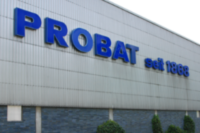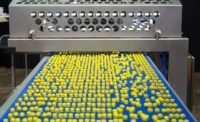
There are three basic types of twisting: preformed candy double-twist, sachet wrap, and cut-and-wrap - an appropriate name since the candy rope is actually cut and wrapped in one step.
For preformed candy, there are two basic types of machines: length-twisters and cross-twisters.
Length-twisters are fairly uncommon and supplied primarily by Bosch and Tenchi, whereas cross-twisters are offered by many more packaging equipment suppliers.
A length-twister forms the film into a long tube (similar to a flow-wrapping machine). Once the candy is positioned inside, a knife cuts the tube. The film then is twisted with the candy in the center of the tube, subsequently followed by the ends being twisted.
A cross-twister cuts a piece off the film, and the candy then is wrapped in this piece. Sachet wrappers all are cross-twisters.
If the film is printed, it’s important to point out that there are two different orientations when comparing a cross-twister to a length-twister.
The main advantage with the length-twisters is that the manufacturer can run very thin films. The drawback, however, stems from not being able to center the print over the body of the candy. Nearly all cut-and-wrap machines are cross-twisters.
Twist-wrapping machines come in a variety of speeds and capabilities, some running at 100 pieces per minute, while others can achieve speeds up to 2,000. There even are Model K machines in operation that date back to the early 1900s, with a few hand-cranked versions still in use.
Just as there are many different twist-wrap machines, so, too, are there different packaging materials. Cellophane used to dominate the transparent twist-wrap market. Nevertheless, as environmental legislation around the world made it increasingly more difficult to produce, availability became an issue.
For a few remaining candy producers, the production cost made cellophane cost prohibitive. Still, cellophane probably is the most forgiving material and technically superior to most other films.
Wax paper dominates the cough drop market and some cut-and-wrap products such asTootsie Rolls. Wax paper is an inexpensive material, but it has two main issues: wax build-up in the wrapping machines and, to a lesser extent, on the product, as well as a predisposal to brittleness over time.
As the cost of cellophane went up, new materials entered the stage. During the early 1980s, Cast Polypropylene (CPE) became available. This material now dominates the market for preformed candy.
Recently a Cast Polyethylene (CPE) film was introduced by several companies, including Multifilm, which displays all the advantages of cellophane and none of the draw backs.
Polyvinyl Chloride (PVC) films have and continue to be used. In addition, polyester and Poly Lacti Acid (PLA) films have emerged.
Most of these materials work well on modern twist-wrapping machines. The choice of material revolves around cost, feel and twist tightness.
Release properties, or how well the film doesn’t stick to the candy, noise or crinkle, are other considerations.
The environmental impact of these films has long been ignored in North America. In Europe, environmental concerns rule. PVC has died out, by and large, in Western Europe, as this material does not fit into any recycling program and causes major concerns when burned.
PLA, which is made out of cornstarch, lacks the barrier and release properties needed for confections. Thus, it’s often coated with Polyvinylidene Chloride (PVC) to give the desired properties, which, in turn, reduces or even prevents biodegradation. Moreover, this film is somewhat noisy and, therefore, considered not very theater friendly.
The polyester versions available work well on machines with 2.5 revolutions of twist or more - mainly roll wrappers for products such asSmartiesand similar. CPP and CPE are recyclable, and both have excellent twist properties.
The choice of material also depends on the product to be wrapped, the shape of this product and the machine. Traditionally, in the United States, hard candy is twist-wrapped, whereas bite-sized chocolate is flow-wrapped.
In Europe, it’s quite the opposite. There, chocolate manufacturers have made use of the excellent protection that twist-wrapping offers. The twist bows provide outstanding shock absorption when the product is packaged in boxes, bags or sold in bulk or as change-makers. Those characteristics, combined with the easy opening aspect of a twist, facilitated the practice of twist-wrapping chocolates in Europe.
Today, many of the twist-wrapping films on the market are supplied clear, white or metalized. Even stripe-metalizing is available from specialized converters. More recently, demetalizing - the process of allowing a metalized film to sport a clear window or product names and logos - has emerged.





